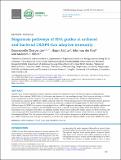Files in this item
Biogenesis pathways of RNA guides in archaeal and bacterial CRISPR-Cas adaptive immunity
Item metadata
| dc.contributor.author | Charpentier, Emmanuelle | |
| dc.contributor.author | Richter, Hagen | |
| dc.contributor.author | van der Oost, John | |
| dc.contributor.author | White, Malcolm F | |
| dc.date.accessioned | 2015-11-05T14:40:02Z | |
| dc.date.available | 2015-11-05T14:40:02Z | |
| dc.date.issued | 2015-05-20 | |
| dc.identifier | 208698945 | |
| dc.identifier | 2dfc771c-b83f-4974-a6bd-d3f44d736b5d | |
| dc.identifier | 84942746261 | |
| dc.identifier | 000355841200011 | |
| dc.identifier.citation | Charpentier , E , Richter , H , van der Oost , J & White , M F 2015 , ' Biogenesis pathways of RNA guides in archaeal and bacterial CRISPR-Cas adaptive immunity ' , FEMS Microbiology Reviews , vol. 39 , no. 3 , pp. 428-441 . https://doi.org/10.1093/femsre/fuv023 | en |
| dc.identifier.issn | 1574-6976 | |
| dc.identifier.uri | https://hdl.handle.net/10023/7745 | |
| dc.description | EC is supported by the Alexander von Humboldt Foundation, the German Federal Ministry for Education and Research, the Helmholtz Association, the Göran Gustafsson Foundation, the Swedish Research Council, the Kempe Foundation and Umeå University. HR is supported by an Helmholtz Post-doctoral Fellowship. JO is supported by the Netherlands Organization for Scientific Research (NWO). | en |
| dc.description.abstract | CRISPR-Cas is an RNA-mediated adaptive immune system that defends bacteria and archaea against mobile genetic elements. Short mature CRISPR RNAs (crRNAs) are key elements in the interference step of the immune pathway. A CRISPR array composed of a series of repeats interspaced by spacer sequences acquired from invading mobile genomes is transcribed as a precursor crRNA (pre-crRNA) molecule. This pre-crRNA undergoes one or two maturation steps to generate the mature crRNAs that guide CRISPR-associated (Cas) protein(s) to cognate invading genomes for their destruction. Different types of CRISPR-Cas systems have evolved distinct crRNA biogenesis pathways that implicate highly sophisticated processing mechanisms. In Types I and III CRISPR-Cas systems, a specific endoribonuclease of the Cas6 family, either standalone or in a complex with other Cas proteins, cleaves the pre-crRNA within the repeat regions. In Type II systems, the trans-acting small RNA (tracrRNA) base pairs with each repeat of the pre-crRNA to form a dual-RNA that is cleaved by the housekeeping RNase III in the presence of the protein Cas9. In this review, we present a detailed comparative analysis of pre-crRNA recognition and cleavage mechanisms involved in the biogenesis of guide crRNAs in the three CRISPR-Cas types. | |
| dc.format.extent | 1310755 | |
| dc.language.iso | eng | |
| dc.relation.ispartof | FEMS Microbiology Reviews | en |
| dc.subject | QR180 Immunology | en |
| dc.subject.lcc | QR180 | en |
| dc.title | Biogenesis pathways of RNA guides in archaeal and bacterial CRISPR-Cas adaptive immunity | en |
| dc.type | Journal item | en |
| dc.contributor.sponsor | BBSRC | en |
| dc.contributor.institution | University of St Andrews. School of Biology | en |
| dc.contributor.institution | University of St Andrews. Biomedical Sciences Research Complex | en |
| dc.identifier.doi | 10.1093/femsre/fuv023 | |
| dc.description.status | Peer reviewed | en |
| dc.identifier.url | http://femsre.oxfordjournals.org/content/39/3/428.figures-only | en |
| dc.identifier.grantnumber | BB/K000314/1 | en |
This item appears in the following Collection(s)
Items in the St Andrews Research Repository are protected by copyright, with all rights reserved, unless otherwise indicated.

